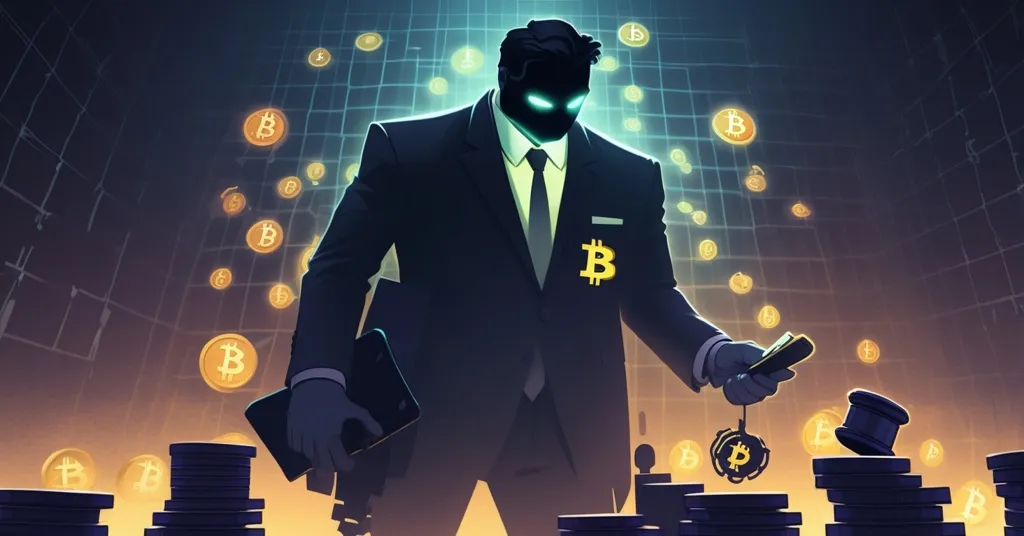Weirdest Bitcoin Heist: OP_RETURN Dusting Targets $284B in Dormant Wallets for Legal Claims

Weirdest Bitcoin Heist? OP_RETURN Dusting Targets Dormant Wallets in Legal Claim Gambit
A shadowy outfit dubbed “_salomon Brothers” has unleashed a jaw-dropping scheme, targeting over 39,000 dormant Bitcoin wallets holding a staggering 2.334 million BTC—worth roughly $284 billion at today’s price of $121,614 per coin. Using Bitcoin’s OP_RETURN feature to embed “legal notices” directly on the blockchain, this unprecedented dusting campaign claims “constructive possession” of what they call abandoned digital assets, issuing a 90-day ultimatum to owners. This bizarre clash of legal posturing and cryptographic reality has the crypto world buzzing with questions about ownership, security, and the future of unclaimed funds in a decentralized system.
- Unmatched Scale: Over 41,000 OP_RETURN messages sent to 39,423 dormant wallets with 2.334M BTC.
- Legal Posturing: Notices assert “constructive possession,” demanding owners prove control by October 10, 2025.
- No Technical Threat: Bitcoin’s protocol remains secure with no flaws or key breaches detected.
The Scale of the OP_RETURN Blitz
In late June 2025, an entity operating as “Salomon Brothers” kicked off a calculated operation that’s unlike anything seen in Bitcoin’s history, detailed in reports about the strangest Bitcoin heist attempt yet. From 3,738 sender addresses, they fired off 41,523 OP_RETURN messages to 39,423 recipient wallets that have been inactive for an average of 2,171 days—nearly six years of digital slumber. These wallets, overwhelmingly legacy P2PKH types (the old-school address format from Bitcoin’s early days before more secure standards emerged), collectively hold a treasure trove of 2.334 million BTC. For context, that’s a chunk of wealth so massive it could sway markets if moved—or claimed.
OP_RETURN, for those new to the tech, is a Bitcoin script opcode that lets users tack on small bits of data—up to 80 bytes—onto transactions recorded on the blockchain. Often used for harmless metadata or quirky messages, it’s been twisted here into a megaphone for pseudo-legal warnings. The campaign rolled out in waves: test transactions in June, followed by full-blown “LEGAL NOTICE” messages with linked URLs in July and August. These notices assert that the targeted wallets seem “lost or abandoned,” claim “constructive possession” on behalf of a Salomon client, and give owners until October 10, 2025, to respond or face potential legal consequences.
Legal Trickery or Legitimate Claim?
So, what’s the play here? Galaxy Research, a trusted name in crypto forensics, dissected the campaign and offered a chilling theory. Their analysis points to an attempt to leverage unclaimed-property laws—rules in some jurisdictions, like certain U.S. states, that allow governments to seize assets deemed abandoned after years of inactivity, a process called escheatment. Think of it like a state taking over an untouched bank account after a decade of silence. “Constructive possession,” as defined by legal sources like Cornell Law’s Legal Information Institute, means having legal control over something without physically holding it—like a landlord claiming ownership of forgotten tenant property.
“Given the OP_RETURN campaign’s scale, the messages’ contents, and the notices they linked to, a plausible interpretation is that whoever is behind them may try to wage legal claims on unresponsive wallets,” Galaxy Research noted.
Salomon Brothers seems to be building a paper trail, hoping that if owners don’t respond, they can argue abandonment in some courtroom somewhere. But here’s where it gets murky: Bitcoin doesn’t operate under any one jurisdiction. It’s a borderless, decentralized network. If a wallet owner is in Japan, the claimant in the U.S., and the blockchain itself is everywhere and nowhere, who even decides? And more critically, how do you enforce a legal ruling on a system where control is dictated solely by private keys?
“The legal viability and possible reach [of these claims] are questionable,” Galaxy Research cautioned.
Bitcoin’s Code vs. Courtroom Drama
Let’s cut to the chase: Bitcoin doesn’t care about your fancy law degree or sternly worded notices. Ownership in this world boils down to one ruthless principle—control the private key, control the funds. No key, no access. No court ruling can execute a transaction on the Bitcoin blockchain without that cryptographic proof. Galaxy Research confirmed there’s zero evidence of protocol flaws or compromised keys in this campaign. Salomon Brothers isn’t hacking their way in; they’re gambling on legal maneuvering to stake a claim to funds they can’t touch—yet.
This isn’t a heist in the Hollywood sense, with ski masks and brute-force attacks. It’s a shameless land grab in digital territory, a slow-burn attempt to squat on blockchain real estate worth billions. Salomon Brothers’ public stance doesn’t help their case. They’ve framed this as a “compliance exercise meant only for the wallet owner,” insisting their mysterious client is “not a hacker and not phishing.” Forgive the skepticism, but plastering legal threats on an immutable ledger reeks of predatory opportunism dressed up as compliance—a wolf in legal sheep’s clothing.
The effort is framed as a “compliance exercise meant only for the wallet owner,” with the client “not a hacker and not phishing,” according to Salomon Brothers’ statements.
The Other Side: Is Salomon Brothers Onto Something?
Let’s play devil’s advocate for a moment, unsettling as it may be. There’s a kernel of debate worth dissecting here. Unclaimed assets—whether fiat in a dusty bank vault or BTC in a forgotten wallet—pose a philosophical question: should wealth sit idle forever if its owner is gone for good? In traditional systems, escheatment laws exist to redistribute abandoned resources, often to public coffers. If a Bitcoin wallet hasn’t moved in a decade, likely due to lost keys or a deceased owner, is there merit to finding a mechanism to unlock that value? Salomon Brothers’ approach may stink of opportunism, but it unwittingly raises a point about dormant capital in any economy, crypto or not.
That said, Bitcoin wasn’t built for centralized meddling. Its beauty lies in cutting out middlemen and enforcing ownership through code, not courthouses. Legal vultures circling unclaimed funds threaten to erode that ethos, turning a trustless system into a bureaucratic battleground. And let’s not kid ourselves—governments eyeing unclaimed crypto as a revenue jackpot could be the real endgame if precedents are set.
A Whale Awakens: Coincidence or Catalyst?
Adding fuel to the fire, a long-dormant whale wallet jolted awake in early July 2025, shifting a massive 80,000 BTC shortly after the campaign began. Was this sleeping giant spooked by Salomon’s notices, one of the targeted addresses finally stirring to life? Or just coincidental timing in a bull market already humming with activity? We can’t know for sure, but it highlights a broader truth: dormant wallets aren’t just relics—they’re ticking time bombs of value and volatility. If more whales wake up en masse, whether due to legal prodding or other triggers, the market could see wild swings. A silver lining, perhaps—could this shady campaign accidentally boost network activity by nudging HODLers out of hibernation?
Historical Context: Dusting Attacks Evolve
For those unfamiliar, dusting attacks aren’t new to Bitcoin. Back in 2018-2019, bad actors sent tiny BTC amounts to thousands of wallets, hoping to track owners’ identities by tracing subsequent transactions—a privacy invasion tactic. This Salomon Brothers campaign flips the script. Instead of de-anonymization, it’s using dusting as legal leverage, embedding OP_RETURN notices to build a case for abandonment. It’s a novel evolution of an old trick, proving that on-chain data can be weaponized in ways beyond mere spying. Bitcoin’s transparency, often a strength, becomes a double-edged sword when opportunists exploit it for courtroom ammo.
What It Means for HODLers and the Crypto Space
This isn’t just a weird blip in Bitcoin’s timeline—it’s a preview of the messy collision between decentralized tech and centralized legal frameworks. As regulators worldwide scramble to define rules for virtual currency, stunts like this expose the growing pains of a maturing ecosystem. Bitcoin’s core promise of “not your keys, not your crypto” faces a new kind of threat, not from hackers but from suits dreaming up ways to override code with contracts. Could this spark overreach, with governments latching onto unclaimed crypto as a fiscal windfall? Or will it fizzle out as an unenforceable gimmick? The uncertainty alone is enough to make any HODLer sweat.
Beyond Bitcoin, other blockchains aren’t immune. Ethereum’s smart contracts, for instance, could theoretically be used to spam similar legal notices, though Bitcoin’s bearer-asset simplicity makes it a riper target for now. This campaign signals a broader risk across crypto: as adoption grows, so does the overlap between on-chain actions and off-chain consequences. The community’s response—though speculative at this stage—could shape the narrative. Are developers mulling limits on OP_RETURN data to curb abuse? Are veteran HODLers shrugging this off as noise, or quietly moving funds to signal control? The silence from core contributors so far speaks volumes about the oddity of this non-technical threat.
How to Protect Your Bitcoin from Legal Vultures
Bitcoiners, take note: dormancy might be the new vulnerability in a world where legal eagles are sniffing around. Protecting your stack doesn’t just mean guarding against hackers—it means staying ahead of bizarre schemes like this. Periodically send a small transaction—a few sats will do—to prove ownership on-chain. Use hardware wallets to secure private keys offline, and document recovery phrases in a safe, offline manner (no cloud storage, please). If your funds are split across old legacy addresses like P2PKH, consider migrating to modern formats like SegWit for added security and lower fees. Staying active, even minimally, sends a clear message: these coins aren’t abandoned, so back off.
Key Takeaways and Questions for Bitcoin Enthusiasts
- What Is the Salomon Brothers OP_RETURN Campaign Targeting Dormant Bitcoin Wallets?
A group called Salomon Brothers sent over 41,000 OP_RETURN messages to 39,423 inactive Bitcoin wallets holding 2.334 million BTC, claiming “constructive possession” with a 90-day deadline to respond by October 10, 2025. - How Does Bitcoin’s OP_RETURN Feature Enable Legal Notices on the Blockchain?
OP_RETURN allows embedding small data (up to 80 bytes) in transactions. Here, it’s been exploited to attach “legal notices” on-chain, targeting dormant wallets with pseudo-legal warnings. - Can Legal Claims Like Constructive Possession Override Bitcoin Ownership?
Practically, no—Bitcoin relies on private keys for control, and no legal ruling can execute transactions without them. Untested precedents in unclaimed property laws, however, add uncertainty. - Why Target Bitcoin Wallets Inactive for Nearly Six Years?
These legacy P2PKH wallets, often from Bitcoin’s early era, are likely linked to lost keys or absent owners, making them ideal for abandonment claims under laws targeting idle assets. - What Risks Do Bitcoin Dusting Attacks Pose to HODLers in This Campaign?
No technical risks—Bitcoin’s security holds firm—but legal risks emerge. On-chain notices could support abandonment arguments, so HODLers should move funds occasionally to assert control. - Could This Bitcoin Legal Play Impact Future Crypto Regulation?
It might. This highlights friction between decentralized systems and centralized laws, potentially pushing regulators to target unclaimed crypto or impose stricter rules on dormant digital assets. - How Can Bitcoin Users Protect Wallets from Legal Threats Like Salomon Brothers’ Notices?
Secure keys with hardware wallets, document recovery phrases offline, and make small transactions periodically to prove ownership. Staying active on-chain deters legal opportunists.
Stepping back, this Salomon Brothers saga is a stark reminder of Bitcoin’s unique paradox. Its cryptographic strength ensures ownership is unassailable—unless keys are lost—but that same design leaves room for legal predators to circle unclaimed fortunes with tactics ripped from a dystopian playbook. For now, these billions remain locked behind private keys, or lost to time if those keys are gone. But as the crypto frontier expands, expect more showdowns between code and courts. Bitcoiners, heed the warning: check your wallets, move a sat or two, and don’t let some opportunist in a far-off jurisdiction dream up ways to claim what’s yours. In a world built on trustless tech, staying vigilant is the only defense against the weirdest threats yet.



